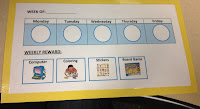 Inappropriate behavior is common among many children with High Functioning Autism (HFA), especially when comorbid conditions exist as well (e.g., ADHD, OCD, anxiety). Knowing how to create and utilize behavior plans improves the home environment on multiple levels.
Inappropriate behavior is common among many children with High Functioning Autism (HFA), especially when comorbid conditions exist as well (e.g., ADHD, OCD, anxiety). Knowing how to create and utilize behavior plans improves the home environment on multiple levels. ==> Teaching Social Skills and Emotion Management
Common behavioral techniques for parents of kids on the spectrum include:
- Contingency Management: A child receives a positive outcome or reward if certain conditions are met.
- Modeling: The special needs child observes siblings receiving rewards for appropriate behavior.
- Planned Ignoring: The parent ignores the problem behavior to reduce negative attention-seeking behaviors.
- Proximity Control: This technique involves placing the child closer to the parent (e.g., at the dinner table), or when the parent comes closer to a child who is at risk of engaging in unwanted behavior.
- Signal Interference: This involves having a planned signal with the child as a reminder to redirect inappropriate behavior.
- Social Reinforcement: This is the effective use of parent-attention and praise to promote appropriate behavior (i.e., catch the child in the act of doing things right).
- Token Reinforcement: The child receives a “token” when a clearly defined target behavior is performed. Tokens can be exchanged for a wide variety of reinforcers (e.g., special privileges). It is easily administered with checkmarks or stickers. Tokens should be given immediately after target behavior is performed.
Creating effective behavior plans for kids on the spectrum:
- Describe the targeted misbehavior (be specific)
- Obtain a baseline measure of misbehavior (i.e., frequency or duration of misbehavior)
- Determine what causes the behavior
- Determine what is reinforcing to a child
- Consider additional supports that might be needed
- Define roles of those involved in the intervention
- Document everything
- Use positive recognition and incentives
- Clear and consistent house-rules and consequences are important and can improve situations and prevent many problems
Motivating the special needs child:
Successful behavior plans require the child to become motivated. A parent must first determine what motivates the child by interviewing him or her. Create a menu of potential reinforcers that you are willing to give, and allow the child to choose from the menu.
All parents want their children to be intrinsically motivated (i.e., reinforcement directly from performing a task). Unfortunately, some special needs children are not intrinsically motivated for a variety of reasons. Extrinsic motivators (i.e., reinforcement from outside the performance of a task) are often used to motivate a child to engage in a more appropriate behavior.
Some parents believe that children should not be rewarded for something they should be doing already. But, extrinsic motivators should be temporary. The goal is to motivate the child extrinsically until he or she begins to feel success, and then use intrinsic motivation when the behavior is changed. Extrinsic motivators should be phased out over time to best allow intrinsic reinforcement to provide the motivation.
==> Teaching Social Skills and Emotion Management
An example of extrinsic-intrinsic motivation used properly:
A behavior plan is created for a special needs child who usually completes her school assignments – but consistently fails to turn them in to the teacher for credit. The child is initially rewarded with extra computer time each day she turns in her assignments (as reported by the teacher). After a few weeks of success, she receives a weekly reward for weeks that all assignments are handed in.
Evaluating the behavior plan:
After creating a behavior plan, it is important to evaluate the outcomes. With good baseline data, it will be fairly easy to measure the behavior again and compare. If the plan is working like it should, gradually encourage more independence from your child. If it is not working like expected, determine what is at fault, and revise and monitor closely. Behavior plans that are implemented inconsistently usually fail.
==> Parenting System that Reduces Defiant Behavior in Teens with Autism Spectrum Disorder
==> Launching Adult Children with Autism Spectrum Disorder: Guide for Parents Who Want to Promote Self-Reliance
==> Teaching Social-Skills and Emotion-Management to Children with Autism Spectrum Disorder
==> Parenting Children and Teens with High-Functioning Autism: Parents' Comprehensive Handbook
==> Unraveling the Mystery Behind High-Functioning Autism: Audio Book
==> Crucial Research-Based Parenting Strategies for Children and Teens with High-Functioning Autism
Resources for Neurodiverse Couples:
==> Online Group Therapy for Men with ASD
==> Online Group Therapy for NT Wives
==> Living with ASD: eBook and Audio Instruction for Neurodiverse Couples
==> One-on-One Counseling for Struggling Individuals & Couples Affected by ASD
==> Online Group Therapy for Couples Affected by Autism Spectrum Disorder
==> Cassandra Syndrome Recovery for NT Wives
==> ASD Men's MasterClass: Social-Skills Training and Emotional-Literacy Development
==> Pressed for time? Watch these "less-than-one-minute" videos for on the go.
COMMENTS:
• Anonymous said... Having the same struggle at home and at school with 11 yr old son. Might have to try some if the suggestions
• Anonymous said... I also homeschool and use gametime as incentive and reward for full day of school or whatever is required.
• Anonymous said... I feel for you Tonya as we've had similar situations in our home with our 9 1/2 year old daughter. I've learned that work first before any video games or Ipod is the best result for us. We use that as a reward system instead of an entitlement and so far so good! Good luck!
• Anonymous said... My son is 13 and he just acts like theres no one else that matters but him. He makes up reasons why he cant help us do anything..and just sits in his room playing his video games. If we do ask him to do something anything, he freaks out and yells at us. My husband is his step dad and thinks i should just spank him but i no that isnt going to work. Help how do i handle this.
Post your comment below...










.jpg)


